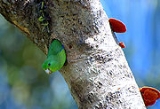
Forpus
Encyclopedia
Forpus is a genus of parrot
in the Psittacidae family.
It contains the following species:
Pacific parrotlets are known to be good talkers and are good at tricks too.
They are also known as biters. Green-rumpeds aren't much of biters but they don't usually
talk as well. Mexican, Spectacled, and Yellow-Faced parrotlets are rarer in the U.S. but are found captive in other places as well.
Dusky-Billed, also more commonly known as Sclater's parrotlets are extremely rare and are only found captive in Europe and even there they are very rare.
Parrots in the Forpus genus make good pets and are very friendly.
They are not easy to breed as Forpus parrots are extremely aggressive and will sometimes kill or severely maim
their partner.
Forpus parrots, also known as parrotlets, are different from the other gender of their species. Males have somewhat dull colors but have a bright blue streak on their wings and eye. Females have bright colors and do not have the blue on the wing. They may or may not have it on the eye. Some parrotlet species are exceptions; but it is usually easy to tell them apart.
Parrot
Parrots, also known as psittacines , are birds of the roughly 372 species in 86 genera that make up the order Psittaciformes, found in most tropical and subtropical regions. The order is subdivided into three families: the Psittacidae , the Cacatuidae and the Strigopidae...
in the Psittacidae family.
It contains the following species:
- Mexican ParrotletMexican ParrotletThe Mexican Parrotlet is a species of parrot in the Psittacidae family.It is endemic to Mexico.Its natural habitats are subtropical or tropical dry forests and heavily degraded former forest.-References:...
(Forpus cyanopygius) - Green-rumped ParrotletGreen-rumped ParrotletThe Green-rumped Parrotlet, Forpus passerinus, is a small parrot. It is a resident breeding bird in tropical South America, from Caribbean regions of Colombia, Venezuela and Trinidad south and east to the Guianas and Brazil, on the downstream Amazon River...
(Forpus passerinus) - Blue-winged ParrotletBlue-winged ParrotletThe Blue-winged Parrotlet is a small parrot found in much of South America. It includes the Turquoise-rumped Parrotlet , which sometimes is treated as a separate species. The Blue-winged Parrotlet is mainly found in lowlands, but locally up to 1200m in south-eastern Brazil...
(Forpus xanthopterygius) - Spectacled ParrotletSpectacled ParrotletThe Spectacled Parrotlet is a species of parrot in the Psittacidae family.It is found in Colombia, Panama, and Venezuela....
(Forpus conspicillatus) - Dusky-billed ParrotletDusky-billed ParrotletThe Dusky-billed Parrotlet , also known as the Sclater's Parrotlet, is a small species of parrot in the Psittacidae family. It is found in the Amazon Rainforest in South America, where it is locally fairly common; it is in the Andes, and the Amazonian foothills; also the Amazon River outlet, and...
(Forpus modestus) - Pacific ParrotletPacific ParrotletThe Pacific Parrotlet , also known as Lesson's Parrotlet or the Celestial Parrotlet, is a species of small parrot in the Psittacidae family, native to Ecuador and Peru...
(Forpus coelestis) - Yellow-faced ParrotletYellow-faced ParrotletThe Yellow-faced Parrotlet is a species of parrot in the Psittacidae family.It is endemic to dry woodland, riparian thickets and scrub in the Marañón Valley in northern Peru....
(Forpus xanthops)
Pacific parrotlets are known to be good talkers and are good at tricks too.
They are also known as biters. Green-rumpeds aren't much of biters but they don't usually
talk as well. Mexican, Spectacled, and Yellow-Faced parrotlets are rarer in the U.S. but are found captive in other places as well.
Dusky-Billed, also more commonly known as Sclater's parrotlets are extremely rare and are only found captive in Europe and even there they are very rare.
Parrots in the Forpus genus make good pets and are very friendly.
They are not easy to breed as Forpus parrots are extremely aggressive and will sometimes kill or severely maim
their partner.
Forpus parrots, also known as parrotlets, are different from the other gender of their species. Males have somewhat dull colors but have a bright blue streak on their wings and eye. Females have bright colors and do not have the blue on the wing. They may or may not have it on the eye. Some parrotlet species are exceptions; but it is usually easy to tell them apart.

